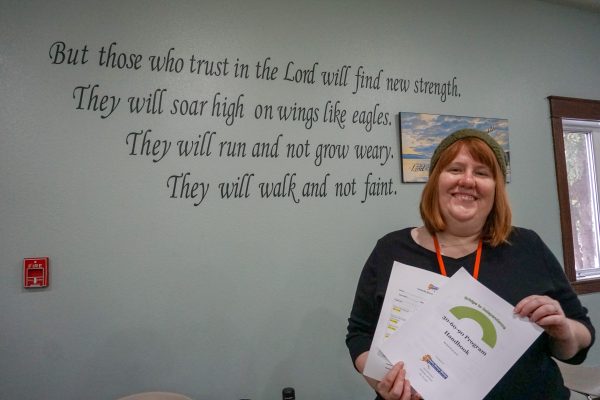Alaska shelter helps homeless promptly find work, home and stability

When Linda Baker moved from Minto to Fairbanks (central Alaska) a few months ago, she didn’t expect to end up in a homeless shelter.
“Things just kinda fell apart,” she explained. “We were gonna come up here to work, and life just life in the way.”
Their housing fell through. Their car broke down. She landed at the Fairbanks Rescue Mission, a sober facility that offered emergency housing, food, and showers. It’s a nice place. People chat companionably in clean, well-lit rooms. They have warm beds and hot coffee.
“And it’s safe here. It is really safe,” Linda emphasized.
Indefinite stay
For Linda and for hundreds of others over the years, being at the Mission felt relatively great. Which was part of the problem.
For years, some people would come to the Mission and never leave. It started to weigh on the staff, many of whom had been homeless themselves at one point. Morale was down and they began to complain at staff meetings, loudly and often.
“People we’re kinda like ‘I don’t want to come here every day and see people regressing or stuck. I want to see people moving forward,’” said Brenda McFarlane, the Mission’s transitional program coordinator.
People could stay at the shelter indefinitely, so some never made plans to leave. They worked in the summer, spent the winter at the mission.
A program to get people moving
The staff decided that if they really wanted to help people move on and find stability, the clients needed deadlines, structure, and more support. A new program was born.
Rodney Gaskins, the executive director, said now when people enter the Rescue Mission they’re given a clear message:
“’Your stay at the Rescue Mission is temporary. Our goal is to add value to you and send you back into the community. Don’t waste the time because you’re gonna be moving.’”
They created the 30-60-90 program.
Within the first 30 days of the program, people have to complete four tasks: register with a statewide job search tool, apply for public assistance, apply for public housing, and get a tuberculosis test.
The next step lasts 60 days. Case managers help participants look for jobs and stay healthy. Rodney said they hold people to high standards and provide guidance to help them accomplish tasks on their own. When someone is struggling, he and Brenda tag-team the motivational talks.
Brenda, a former teacher, plays the tough love role.
“’Just so you know, you really to get on track. If you’ve been here this long, you don’t have much longer,’” she said she tells program participants who are falling behind. Then Rodney, a former military man, jumps into to the conversation, reassuring them they are capable. “He comes in [saying] ‘You’re all on a journey,’” Brenda recaps, laughing with her colleague.
Giving useful advice
They laughed and joked, saying they try to keep things fun to help keep people motivated. Together they try to get participants to the last 90 days, when they work on saving money and transitioning into permanent housing. They also take classes on how to be a good renter and how to handle grief, anger, and trauma.
Along the way, participants and staff come together for weekly meetings to talk about upcoming community events, share advice on job hunting, and discuss challenges such as transportation for people working the night shift. They celebrate the small successes.
At a recent meeting, Linda received a certificate for finishing the first four tasks. As she walked to the front of the room, everyone clapped and cheered. She said it felt good.
Since the program began in July of 2016, more than 300 people have earned certificates. About 170 have received case management. People who didn’t participate in the 30-60-90 program or other shelter programs were asked to leave the shelter once they hit their 30-day-per-year limit.
Rodney said they don’t have hard data about how successful the program has been because most people never come back to the Mission to give updates. Others leave the program before the 180 days are up. They do have anecdotal evidence that people are moving on, and participants say it helps.
Giving people structure
Linda’s only been at the shelter a few weeks, and she says having to complete a set of tasks gave her the structure she needed when she felt lost.
“Because I never would have thought of having a deadline to go to Alaska Housing, go to the job service. Because you kind of lose yourself (when you are homeless),” she said. “Kinda drown in yourself.”
Now she’s looking for jobs in kitchens and trying to learn computer skills so she can find less physical work as she ages.
She said people at the Mission remind her that she does have the strength to stand on her own and move on. One little step at a time.
Related stories from around the North:
Canada: Financial literacy must improve for Indigenous Canadians says government agency, Eye on the Arctic
Finland: Jobs on the upswing for Finns, but structural problems linger, YLE News
Iceland: 10% of Iceland’s workforce employed in tourism, The Independent Barents Observer
United States: Indigenous Alaskans find strength in community and tradition, Alaska Public Media



